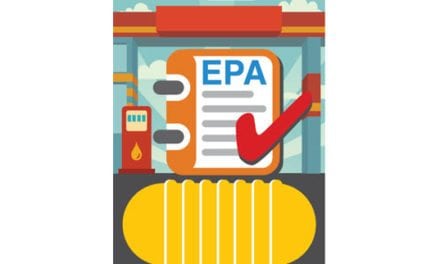The article is bought to you by Invenco, a NACS supplier member.
 Dan Harrell
Dan Harrell
Chief Innovation Officer
Invenco
www.invenco.com
You describe Invenco as a “payments company” vs. an equipment company. What do you mean by that?
Although they may appear as one integrated unit, a dispenser’s fuel pump and pay-at-pump systems are completely separate equipment. The variation between complexity of function, integrations, communications, regulation update intervals, security requirements, product life cycle, innovation pace and customer engagement opportunities all highlight the differences between these seemingly cohesive devices.
Invenco prides itself on being a payments company because, although a segment of our solutions focuses on the retail fuel market, the root of our product development process is payments technology and services. We build our products to align with the payment industries’ latest standards, consumer trends and regulatory requirements to ensure that the systems’ main function—payment transactions—is enabled to the highest possible standard. Then, once we have addressed the foundation of security, PCI, EMV, contactless, mobile, extensibility and customer UX, we develop the integrations with supporting forecourt technology. The result is a product that successfully addresses the nuances of forecourt payments, while staying ahead of providers whose focus is manufacturing fuel equipment.
What are some aspects of the payments industry that have impacted or will impact the retail fuel market?
Payments industry initiatives generally address consumer security, consumer preference or merchant opportunity, while the major retail fuel initiatives are outdoor EMV and contactless payments. EMV can be categorized as consumer security and has retailers wondering how to extract value from related hardware investments. Consumer preference has driven contactless payments, with the COVID-19 pandemic triggering significant change in interactions on the forecourt and within the c-store.
In the merchant opportunity category, open platform systems and a standard communication protocol have made their way from the payments to the retail fuel market conversation. Both an open platform and communication standard (between all associated retail systems) will be important factors as the industry drives the evolution of digital solutions to differentiate offerings.
Can you dive deeper into how a universal standard for pay-at-pump to POS system communications would impact the industry?
The universal standard refers to implementing a set protocol for communications between the in-store and pay-at-pump system. In our current state, protocols differ by pay-at-pump provider and are generally not shared except under closed agreements. This closed approach limits innovation and the ability to extend customer engagement for EMV pay-at-pump solutions. For new or third-party providers, there are often seemingly endless hurdles or excessive fees to cross when working toward approval from POS providers to integrate with their systems.
For retail fuel, this means that innovative, cost-effective systems are blocked from entering the market. Ultimately, the retailers are hurt the most, as proprietary solutions can dictate high pricing while discouraging innovation and competition between providers.
Retailers should encourage their technology providers to ensure that they advocate for them by adopting the recently enacted Conexxus Standard for Forecourt Payment Terminal communication. The standard ensures that all pay-at-pump solution providers have the necessary information to deliver equipment to the marketplace.
You mentioned the importance of an open platform in the payments industry. Can you expand on what this looks like on the forecourt?
An open platform enables retailers to leverage their pay-at-pump terminals to engage customers in ways previously not possible. Food ordering, loyalty and media programs are examples of revenue-generating capabilities that mark the beginning of customer engagement potential on the forecourt. An open platform will enable seamless integrations to the site’s existing system via third-party plugins and applications they or their representatives can develop on their own designated timelines. Retailers whose forecourt systems are not open platform may find themselves unable to keep up with the latest forecourt offerings because they are burdened with driving the priority with their technology provider.
Additionally, with so much recent consolidation, open platform pay-at-pump systems allow retailers to manage their assets from one central location, no matter the dispenser or POS type. For businesses looking to expand, this is a crucial step in moving forward as things like asset information, software/compliance upgrades, media playlists and device status become difficult to manage across several systems.
What steps should retailers take today to ensure their technology will align with these concepts?
Be aware that there are long-standing barriers that make it difficult for new providers to enter the forecourt payments market. This means higher prices and less motivation for current providers to innovate their products. To remove these barriers, retailers should encourage their technology providers to enact the Conexxus Standard for Forecourt Payment Terminal communication between in-store and pay-at-pump systems.
When exploring pay-at-pump systems, retailers should make sure they run on an open-platform architecture and support the Conexxus standards. For retailers looking to drive revenue with their EMV equipment upgrades, an open system terminal with media capabilities is a great way to open this world of opportunities. By taking these steps, retailers can be confident that their payment system investments will drive value at their sites today, while enabling the future innovations of tomorrow.









